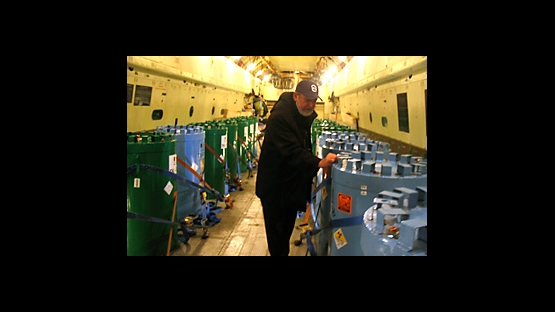Rossendorf, Germany -- The IAEA today supported the largest ever return of highly enriched uranium from a civilian research reactor back to Russia. At the end of a five-day operation, 268 kg of fresh highly enriched uranium fuel (HEU) and 58 kg of fresh low-enriched uranium fuel (LEU) were taken from a German research reactor, airlifted and safely delivered to Russia, where the fuel originated.
The mission was carried out under tight security measures and jointly by Germany, the Russian Federation, the US and the IAEA. The German federal state of Saxony has covered the cost of the return. Russia will downblend the HEU into LEU for further civilian use in a facility at Podolsk near Moscow.
IAEA safeguards inspectors have monitored the loading of the total of 326 kg of non-irradiated fuel to 18 special transportation containers at the former research reactor site in Rossendorf near Dresden and have sealed them. They were joined by experts from both the US National Nuclear Security Administration (NNSA) and from Russia during this process and during the departure of the cargo plane from Dresden Airport.
The removal was carried out under an IAEA Technical Cooperation project, entitled "Repatriation, Management and Disposition of Fresh and/or Spent Nuclear Fuel from Research Reactors". This project supports the US-funded Global Threat Reduction Initiative (GTRI) that aims to identify, secure and recover high-risk vulnerable nuclear and radiological materials around the globe.
With extra-budgetary funding from NNSA of the US Department of Energy, the IAEA had so far facilitated 11 shipments of a total of 165 kg of fresh HEU from eight countries, namely Serbia, Romania, Bulgaria, Libya, Uzbekistan, Czech Republic, Latvia and Poland.
"Today´s 12th batch from Rossendorf not only represents the first such shipment from Germany to Russia, but also brings the total amount of fresh HEU repatriated to Russia to a record amount of 433 kg," said Arnaud Atger, the Project Manager at the IAEA.
"This action is an important step towards promoting a global cleanout of HEU in the civilian sector," he added. "The security of HEU is of particular concern due to the technical feasibility of constructing a crude nuclear explosive device from HEU."
Andrew Bieniawski, Deputy Administrator of NNSA, also emphasized the importance of the joint US-Russia-IAEA programme, entitled the Russian Research Reactor Fuel Return (RRRFR), which is aimed at supporting the return to Russia of fresh or irradiated HEU and LEU fuel: "Every kilogram of material that is moved is one less kilogram of material that could be used by terrorists to make a bomb. The total amount of 326 kg of fresh fuel is the largest ever shipment ever done under our programme."
He praised Germany´s funding of the return mission: "Germany demonstrates a leadership by this funding. It is a sign of the shared responsibility that we all have."
The HEU fuel that was returned today was supplied by the USSR to the former German Democratic Republic in 1960s and 1970s. After the reunification of Germany in 1989, the Federal Government decided to shut down the two Soviet-design research reactors at Rossendorf, which were decommissioned in 1991 and 2005. The fresh fuel was since then kept under strict security measures at the site.
Saxony´s Science Minister Eva Maria Stange said the fuel return would save her state budget one million euros a year: "This joint operation means more security for our citizens, and more money to be spent for more useful purposes instead of securing old nuclear burden."
She thanked the IAEA for "the significant responsibility it carried for securing the material" and added: "The return mission emphasizes the multi-lateral work so that the nuclear fuel does not fall into the hands of the wrong people."
Research reactors produce radioisotopes for medicine and industry, for research in physics, biology and material science, and for scientific education and training.
More than half of all the operational research reactors worldwide - 132 out of 244 - are still fuelled with HEU. This is considered a high-risk material since it can also be used in the making of a nuclear explosive device. In conjunction with the USA´s GTRI programme, the IAEA works with its Member States both to return the fresh or spent fuel and to convert their research reactors to LEU fuel. The final goal is to reduce and eventually eliminate international commerce in HEU for research reactors.


